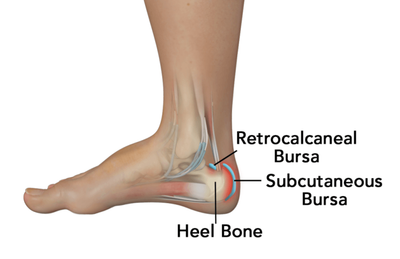Achilles Tendon Bursitis
What is the Achilles Tendon?
The Achilles tendon is a group of soft but tough fibrous tissue that connects the calf muscles to the heel bone.
Contraction of the calf muscles tightens the Achilles Tendon and pulls the heel. This function enables the heel, foot and toe movements necessary for walking, running and jumping.
What is The Achilles Tendon Bursitis?
The retrocalcaneal bursa, a fluid-filled sac, which is located at the back of the heel under the Achilles tendon, contains a lubricating fluid that acts as a cushion to reduce friction between muscle and bones.
Achilles tendon bursitis or retrocalcaneal bursitis is a painful condition caused by swelling of the bursa.
Who does Achilles Tendon Bursitis Affect?
Achilles tendon bursitis commonly occurs in athletes.
Also, children who suddenly increase their level of physical activity are at a higher risk of developing Achilles tendon bursitis.
Causes of Achilles Tendon Bursitis
Achilles tendon bursitis is caused by overuse of the ankle, which results in irritation and inflammation of the bursa. The common causes include:
- Too much of walking,
- Repeated jumping or
- Long distance running.
Achilles tendon bursitis can also occur in conjunction with Achilles Tendinitis, the inflammation of the Achilles tendon.
Achilles Tendon Bursitis can be a secondary injury associated with chronic conditions such as:
- Plantar Fasciitis
- Heel Spurs
- Fibromyalgia
- Rheumatoid arthritis.
Symptoms of Achilles Tendon Bursitis
The most common symptom is pain and tenderness at the back of the heel, especially while walking or running.
Pain increases when standing on tiptoe. In some cases, the skin at the back of the heel may become warm and red.
Prevention of Achilles Tendon Bursitis
Achilles Tendon Bursitis may be prevented by maintaining proper form during exercises.
Ensure some warm-up exercises are performed before starting any sports activity, which may help prevent injury of the Achilles tendon.
Diagnosis of Achilles Tendon Bursitis
Your doctor may diagnose the condition based on:
- your symptoms
- a physical examination of the ankle.
Diagnostic tests such as X-ray and MRI may be required later if the treatment does not improve the symptoms.
Treatment for Achilles Tendon Bursitis
Non-Surgical Treatment
The initial treatment for Achilles tendon bursitis includes:
- Restriction of activities that cause pain.
- Application of ice on the injured area, which will help to reduce the swelling. Ice should be wrapped on a cloth and applied rather than direct application.
- Non-steroidal anti-inflammatory medications may be given to reduce inflammation and pain.
- Custom heel wedges can be used to reduce the stress on the heel.
- Physical therapy may be recommended to help restore and improve the flexibility and strength of the muscles, tendons and joints around the ankle.
If retrocalcaneal bursitis is associated with Achilles Tendonitis, it may be necessary to immobilise the ankle for several weeks until healing takes place.
This can be done by applying a cast on the ankle, which limits ankle movement and allows the tendon to rest.
Surgical Treatment
Surgery is considered only when non-surgical treatments fail to resolve pain and inflammation.
Bursectomy
Bursectomy is a surgical procedure done to remove an inflamed or infected bursa.
Untreated Achilles Tendon Bursitis
Untreated Achilles Tendon Bursitis can lead to prolonged discomfort, tendon tears or rupture.
A rupture of the tendon will most likely require more serious treatment options, including casting or surgery.


